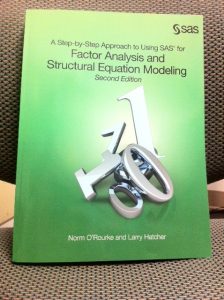Is there a good "fit" between the proposed theoretical model and the data actually obtained? How large are the path coefficients that represent the effects of the antecedent variables on the consequent variables? Do the antecedent variables account for a large percentage of variance in the consequent variables?
 Norm O’Rourke and Larry Hatcher’s new book A Step-by-Step Approach to Using SAS for Factor Analysis and Structural Equation Modeling, Second Edition gently guides users through performing some of the most sophisticated data analysis procedures used by researchers today and can help answer these questions plus more. Structural equation modeling is one of the most important statistical procedures for testing complex causal models with correlational data.
Norm O’Rourke and Larry Hatcher’s new book A Step-by-Step Approach to Using SAS for Factor Analysis and Structural Equation Modeling, Second Edition gently guides users through performing some of the most sophisticated data analysis procedures used by researchers today and can help answer these questions plus more. Structural equation modeling is one of the most important statistical procedures for testing complex causal models with correlational data.
Unlike most existing texts, this book provides clear guidelines to determine sample size requirements for path analysis, confirmatory factor analysis (CFA), and structural equation modeling (SEM). For example, it provides syntax to estimate the statistical power of completed studies. It also provides syntax to estimate minimum sample size requirements for planned research to have confidence in the results (i.e., sample sizes required for CFA and SEM).
Most of the book's examples are drawn from the social and behavioral sciences, but the statistical procedures it covers will be useful to students and researchers in any discipline that makes use of correlational (i.e, nonexperimental) data: business, education, nursing, public health, and biology.
Determining the sample size required to achieve a specific level of statistical power is important to researchers preparing grant proposals, for graduate students completing dissertations, and even for upper-level undergraduates completing honors theses. This is one of the few books that makes these procedures possible within the framework of structural equation modeling.
Delve into the world of measurement and structural equation modeling and uncover solutions to problems encountered in real-world research with A Step-by-Step Approach to Using SAS for Factor Analysis and Structural Equation Modeling, Second Edition.
Read the free excerpt to begin your journey.
